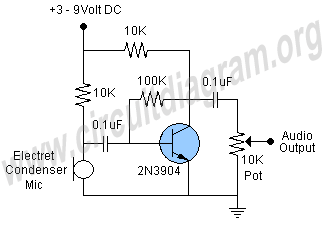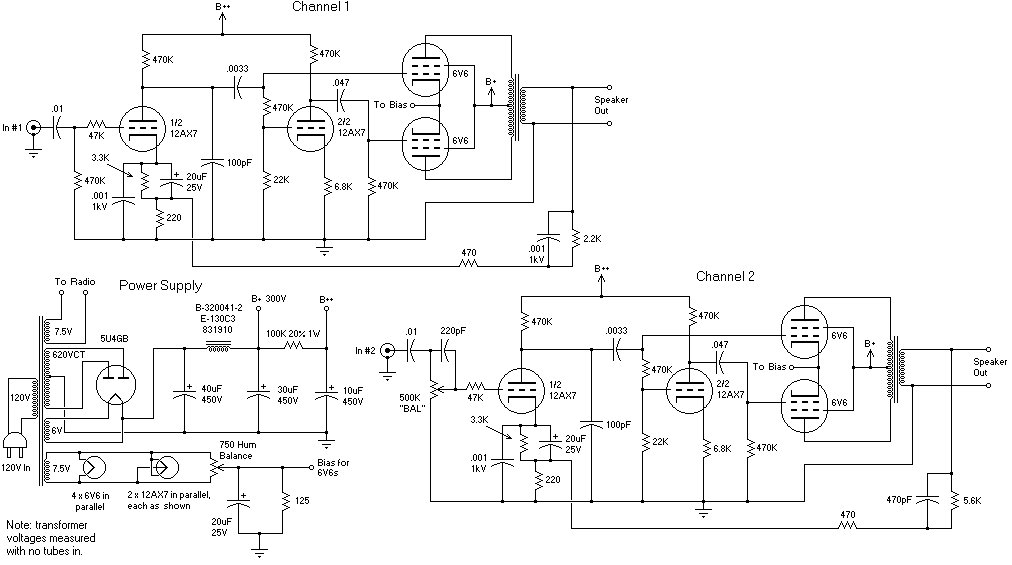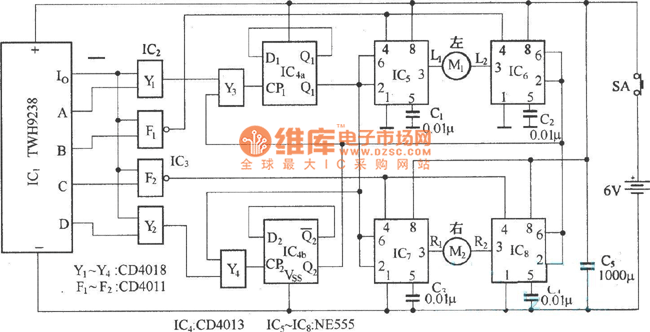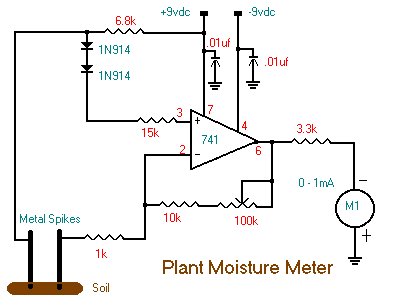
microphone preamp circuit

This schematic illustrates a highly sensitive microphone preamplifier circuit designed to amplify the gain of a microphone or enhance audio signals originating from a microphone. The circuit is straightforward, comprising only a few components, and can be assembled in a matter of minutes if all necessary parts are on hand. This versatile microphone preamp circuit is suitable for various applications. A 10K potentiometer is integrated into the circuit to allow for gain adjustment. The general-purpose transistor 2N3904 is utilized in this design. The circuit operates within a voltage range of 3 to 9 volts DC.
The microphone preamplifier circuit is designed to provide a significant boost to low-level audio signals from microphones, making it an essential component for audio recording and amplification systems. The use of the 2N3904 transistor ensures reliable performance, as it is capable of handling moderate current levels while providing adequate gain.
The circuit layout typically includes an input stage where the microphone signal is fed into the base of the transistor. The 10K potentiometer is strategically placed in the circuit to control the amount of gain applied to the input signal, allowing users to tailor the amplification based on their specific requirements. The output of the transistor is connected to a coupling capacitor to block any DC offset from the output signal, ensuring that only the amplified AC audio signal is sent to subsequent stages or devices.
Power supply considerations are critical for this circuit, as it can operate within a range of 3 to 9 volts DC. This flexibility allows it to be powered by various sources, including batteries and power adapters, making it suitable for portable applications.
Overall, this microphone preamp circuit is an effective solution for enhancing audio signals, and its simplicity and component availability make it an ideal project for both novice and experienced electronics enthusiasts.Here is a schematic of a very sensitive microphone preamp circuit, which can be used to increase gain of microphone or boost the audio signals coming from microphone. The circuit is very simple contains only few components and can be assembled in few minutes if all parts are available.
This is a versatile mic preamp circuit and can be used for man y purposes. The 10K potentiometer is used in the circuit to increase or decrease the gain. Transistor 2N3904 is a general purpose transistor. The circuit can be operated between 3 to 9 volt DC. 🔗 External reference
The microphone preamplifier circuit is designed to provide a significant boost to low-level audio signals from microphones, making it an essential component for audio recording and amplification systems. The use of the 2N3904 transistor ensures reliable performance, as it is capable of handling moderate current levels while providing adequate gain.
The circuit layout typically includes an input stage where the microphone signal is fed into the base of the transistor. The 10K potentiometer is strategically placed in the circuit to control the amount of gain applied to the input signal, allowing users to tailor the amplification based on their specific requirements. The output of the transistor is connected to a coupling capacitor to block any DC offset from the output signal, ensuring that only the amplified AC audio signal is sent to subsequent stages or devices.
Power supply considerations are critical for this circuit, as it can operate within a range of 3 to 9 volts DC. This flexibility allows it to be powered by various sources, including batteries and power adapters, making it suitable for portable applications.
Overall, this microphone preamp circuit is an effective solution for enhancing audio signals, and its simplicity and component availability make it an ideal project for both novice and experienced electronics enthusiasts.Here is a schematic of a very sensitive microphone preamp circuit, which can be used to increase gain of microphone or boost the audio signals coming from microphone. The circuit is very simple contains only few components and can be assembled in few minutes if all parts are available.
This is a versatile mic preamp circuit and can be used for man y purposes. The 10K potentiometer is used in the circuit to increase or decrease the gain. Transistor 2N3904 is a general purpose transistor. The circuit can be operated between 3 to 9 volt DC. 🔗 External reference





